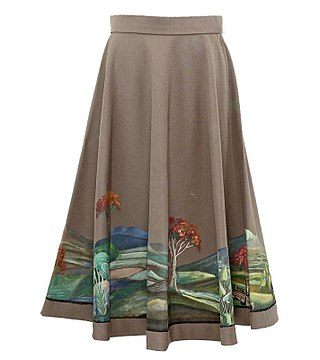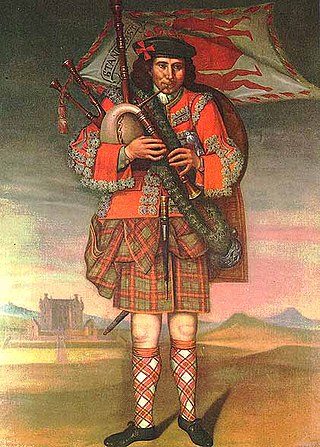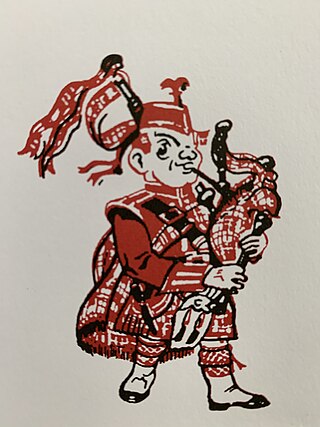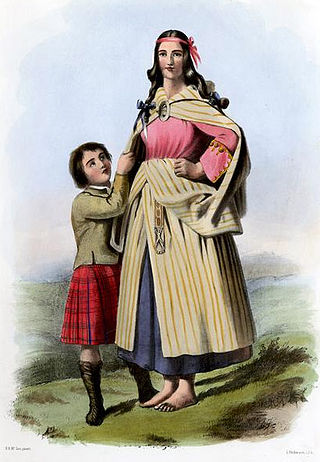
A kilt is a garment resembling a wrap-around knee-length skirt, made of twill-woven worsted wool with heavy pleats at the sides and back and traditionally a tartan pattern. Originating in the Scottish Highland dress for men, it is first recorded in the 16th century as the great kilt, a full-length garment whose upper half could be worn as a cloak. The small kilt or modern kilt emerged in the 18th century, and is essentially the bottom half of the great kilt. Since the 19th century, it has become associated with the wider culture of Scotland, and more broadly with Gaelic or Celtic heritage.

A skirt is the lower part of a dress or a separate outer garment that covers a person from the waist downwards.

Tartan is a patterned cloth with crossing horizontal and vertical bands in multiple colours, forming simple or complex rectangular patterns. Tartans originated in woven wool, but are now made in other materials. Tartan is particularly associated with Scotland, and Scottish kilts almost always have tartan patterns.

The Dress Act 1746, also known as the Disclothing Act, was part of the Act of Proscription which came into force on 1 August 1746 and made wearing "the Highland Dress" — including the kilt — by men and boys illegal in Scotland north of the Highland line running from Perth in the east to Dumbarton in the west. The rest of the Act of Proscription reiterated and reinforced the Disarming Act 1715. The Jacobite risings between 1689 and 1746 found their most effective support amongst the Scottish clans, and this act was part of a series of measures attempting to bring the clans under government control. An exemption allowed the kilt to be worn in the army's Highland regiments along with its veterans who had served in the military. The landed gentry were also exempt, being exempt from the entire Act of Proscription.

Highland games are events held in spring and summer in Scotland and other countries with a large Scottish diaspora, as a way of celebrating Scottish and Celtic culture, especially that of the Scottish Highlands. Certain aspects of the games are so well known as to have become emblematic of Scotland, such as the bagpipes, the kilt, and the heavy events, especially the caber toss and weight over bar. While centred on competitions in piping and drumming, dancing, and Scottish heavy athletics, the games also include entertainment and exhibits related to other aspects of Scottish and Gaelic cultures.
A dirk is a long-bladed thrusting dagger. Historically, it gained its name from the Highland dirk where it was a personal weapon of officers engaged in naval hand-to-hand combat during the Age of Sail as well as the personal sidearm of Highlanders. It was also the traditional sidearm of the Highland Clansman and later used by the officers, pipers, and drummers of Scottish Highland regiments around 1725 to 1800 and by Japanese naval officers.

Highland dress is the traditional, regional dress of the Highlands and Isles of Scotland. It is often characterised by tartan. Specific designs of shirt, jacket, bodice and headwear may also be worn along with clan badges and other devices indicating family and heritage.

Highland dance or Highland dancing is a style of competitive dancing developed in the Scottish Highlands in the 19th and 20th centuries, in the context of competitions at public events such as the Highland games. It was created from the Gaelic folk dance repertoire, but formalised with the conventions of ballet, and has been subject to influences from outside the Highlands. Highland dancing is often performed with the accompaniment of Highland bagpipe music, and dancers wear specialised shoes called ghillies or pumps. It is now seen at nearly every modern-day Highland games event.

The belted plaid is a large blanket-like piece of fabric which is wrapped around the body with the material pleated or, more accurately, loosely gathered and secured at the waist by means of a belt. Typically, a portion of the belted plaid hangs down to about the knees or ankles with the rest of the material being wrapped up around the upper body in a variety of ways and pinned or otherwise secured to keep it in place.

'Aboyne dress' is the name given to the prescribed attire for female dancers in the Scottish national dances, such as the Flora MacDonald's fancy, the Scottish lilt, and others. Male dancers wear the kilt for these dances, the kilt being a predominantly male garment. There are two versions of Aboyne Dress in use. Some consider the Aboyne as quite suited to the graceful movements of the national dances.

Trews are men's clothing for the legs and lower abdomen, a traditional form of tartan trousers from Scottish Highland dress. Trews could be trimmed with leather, usually buckskin, especially on the inner leg to prevent wear from riding on a horse.

Tartanry is the stereotypical or kitsch representation of traditional Scottish culture, particularly by the emergent Scottish tourism industry in the 18th and 19th centuries, and later by the American film industry. The earliest use of the word "tartanry" itself has been traced to 1973. The phenomenon was explored in Scotch Myths, a culturally influential exhibition devised by Barbara and Murray Grigor and Peter Rush, mounted at the Crawford Centre at the University of St Andrews in the Spring of 1981. Related terms are tartanitis, Highlandism, Balmorality, Sir Walter Scottishness, tartanism, tartan-tat, and the tartan terror.

The modern, tailored kilt which is ubiquitous at Highland games gatherings around the world has associated with it an evolving style of wear. This style includes the accessories and other accoutrements which are typically worn with it. In this sense, it is very much like other items of the fashion world.

A Scottish regiment is any regiment that at some time in its history has or had a name that referred to Scotland or some part thereof, and adopted items of Scottish dress. These regiments were created after the Acts of Union in 1707 between England and Scotland, either directly serving Britain during its various wars, or as part of the military establishments of Commonwealth countries. Their "Scottishness" is no longer necessarily due to recruitment in Scotland nor any proportion of members of Scottish ancestry.
The Vestiarium Scoticum is a book which was first published in 1842 by William Tait of Edinburgh in a limited edition. John Telfer Dunbar, in his seminal work History of Highland Dress, referred to it as "probably the most controversial costume book ever written".

The history of the modern kilt stretches back to at least the end of the 16th century. The kilt first appeared as the belted plaid or great kilt, a full-length garment whose upper half could be worn as a cloak draped over the shoulder, or brought up over the head as a hood. The small kilt or walking kilt did not develop until the late 17th or early 18th century, and is essentially the bottom half of the great kilt.

A full plaid, or just a plaid, is a long piece of tartan fabric, most often worn as part of a Highland dress. It usually matches the tartan of the kilt. A modern full plaid is pleated the whole way, with half of its length sewn shut. Its length is about twice the distance from the ground to the wearer's shoulder.

An arisaid is a draped garment historically worn in Scotland in the 17th and 18th century as part of traditional female Highland dress. It was worn as a dress – a long, feminine version of the masculine belted plaid – or as an unbelted wrap. An earasaid might be brightly coloured or made of lachdann wool. Some colours were more expensive than others. The garment might be single-coloured, striped, or tartan – especially of black, blue, and red stripes on white. White-based earasaid tartans influenced later dance and sometimes dress tartans, as well as household-item tartans in a style called "barred blanket" tartan.

A maud is a woollen blanket or plaid woven in a pattern of small black and white checks known as Border tartan, Shepherd's check, Shepherd's plaid or Galashiels grey. It was in common use as an item of clothing in the southern counties of Scotland and the northern counties of England until the early twentieth century.

Regimental tartans are tartan patterns used in military uniforms, possibly originally by some militias of Scottish clans, certainly later by some of the Independent Highland Companies (IHCs) raised by the British government, then by the Highland regiments and many Lowland regiments of the British Army, and eventually by some military units in other countries. The earliest evidence suggesting militia uniform tartans dates to 1691, and the first certain uniform tartan was that of the Royal Company of Archers in 1713. The IHCs raised 1725–29 by the British government appear to have had one or more uniform tartans, though some later ones did not. The first true Highland regiment of the British Army was the 42nd Regiment of Foot formed by amalgamation of the IHCs in 1739, and had its own consistent uniform tartan by 1749 or 1757 at the latest. Some later Highland units also wore this tartan, while others developed minor variations on it, usually by adding bright-coloured over-checks. Some few regiments developed their own tartans not based on Black Watch, including the 75th, 79th, Fraser Fencibles, and Loyal Clan Donnachie Volunteers. Some units developed special tartans for bandsmen and grenadiers.
















